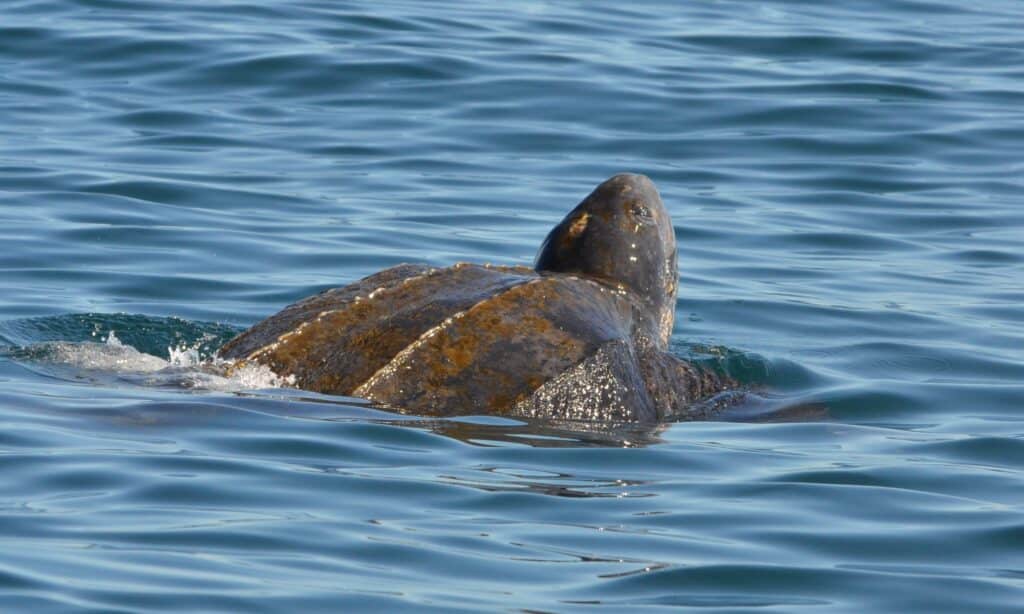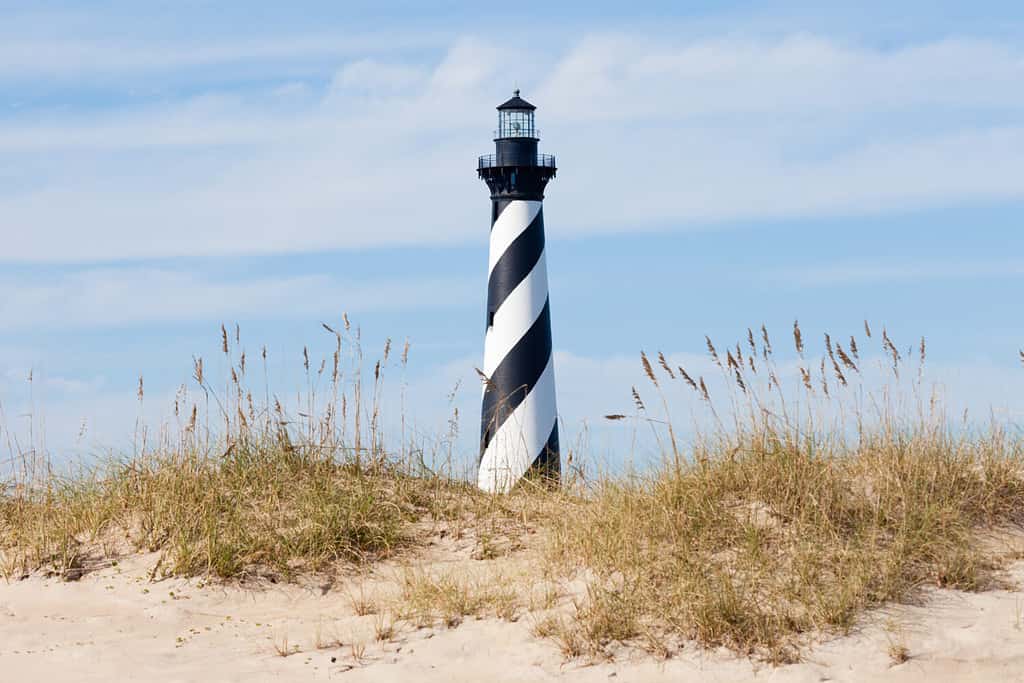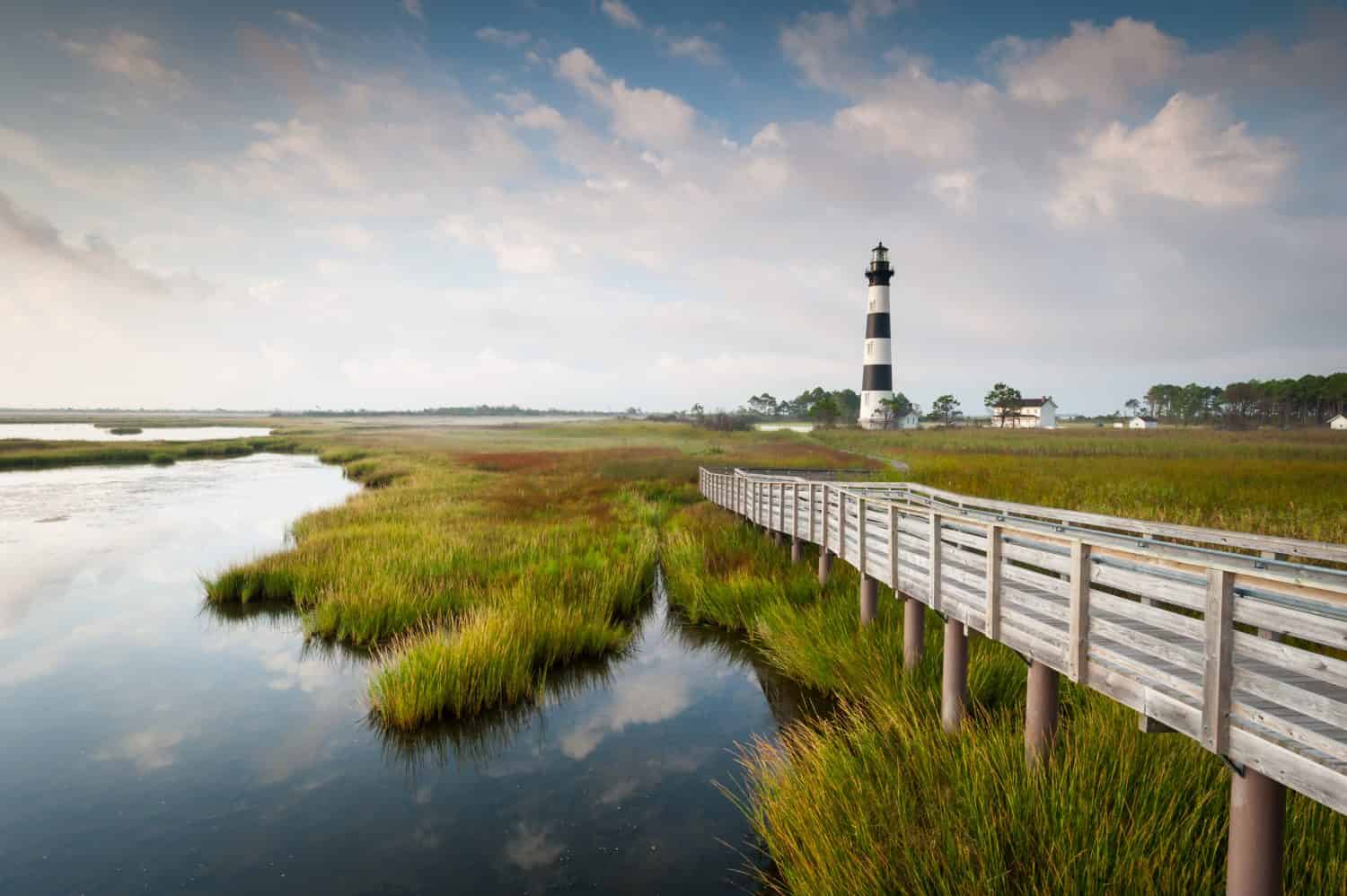North Carolina is home to many different natural wonders. In the Tar Heel State, you can find Mount Mitchell, which is the tallest peak in the United States to the east of the Mississippi River. There’s also Max Patch. Max Patch is a stunning field on top of a mountain where you can camp and wake up to a stunning sunrise. Culturally, there’s no place like Asheville. It is a fantastic getaway that has great food, hiking, music, and so much more to do. In addition to this, North Carolina also boasts one of the longest shorelines in the United States: the Cape Hatteras National Seashore.
Cape Hatteras National Seashore is 70 miles of paradise. It is home to many different kinds of wildlife, from seals to whales to sea turtles. You can also do many different activities here, like camping, hiking, fishing, and much more.
Location
Cape Hatteras National Seashore is a United States National Park, located in North Carolina. It is located in the Outer Banks, a string of thin islands. The Outer Banks extend out into the Atlantic Ocean, away from North Carolina, and then curve back inland. The total coastline of Cape Hatteras National Seashore is 70 miles long, extending from Bodie Island down to Portsmouth Island. The Seashore has many different beaches throughout.
Despite its one million visitors per year, it is easy to feel like the only one on the beach. There’s so much space between beaches, and it’s long enough to be able to find your own secluded spot. However, even if you were not to get out of the car, it is one of the most beautiful and picturesque drives on the East Coast. You can stop at one of the seven villages on Hatteras Island, or drive as far down the seashore as you want. No matter where you end up on the Cape Hatteras National Seashore, you will be able to see some beautiful sights.
Wildlife at Cape Hatteras National Seashore
Cape Hatteras National Seashore is rich in biodiversity, as it is home to many different kinds of wildlife. From sea turtles to snakes, there are many animals that call this place home.
Sea turtles find solace in Cape Hatteras National Seashore. It provides the perfect habitat for the many different kinds of turtles that call it home. Leatherback (Dermochelys coriacea), Kemp’s ridley (Lepidochelys kempii), green (Chelonia mydas), and loggerhead (Caretta caretta) sea turtles are all active in the waters on the Outer Banks.
Depending on when you might visit, you may see the turtles nesting on the beach. Female loggerhead sea turtles tend to lay eggs here regularly. However, if you’re lucky, you’ll also see the leatherback, Kemp’s ridley, and green sea turtles laying eggs at night here too. The gender of the baby turtles is entirely dependent upon the temperature of the sand. Cool sand produces male turtles, and warm sand produces female turtles. You are more than likely to see male baby turtles at Cape Hatteras National Seashore.

Leatherback sea turtles call Cape Hatteras National Seashore home.
©iStock.com/jtstewartphoto
In addition to the sea turtles, you can stumble across seals at Cape Hatteras National Seashore. When the ocean is colder, you may be able to see seals resting and relaxing on the beach, absorbing some of the sunlight’s heat. They typically come out during the winter, when it is cooler and the ocean is colder. While one might think that if you see a seal on the beach it may be in danger, this is not the case. Do not approach; they are just resting on the beach.
There are also opportunities to see dolphins and whales offshore at Cape Hatteras. While it’s fun to see from the beach, you can also go out on a whale- and dolphin-sighting excursion from various boating companies offering the service.
A variety of birds also call Cape Hatteras National Seashore home. The different water birds that visit Cape Hatteras are the common tern, the least tern, the gull-billed tern, and the black skimmer. These birds all nest at the seashore, and they all hunt the fish in the Atlantic. The terns are aerodynamic – they fly quickly and catch fish right at the water’s surface. The black skimmer flies low to the water and skims the surface of the water to catch fish. Both of these varieties of birds set their nests up high on the beach. This protects them from the ocean where the tide may be able to get to them. When they lay eggs and hatch, the terns and skimmers bring small amounts of fish up to the nest to feed their children. After about four weeks, the baby birds begin to fly.
Finally, Cape Hatteras National Seashore is home to many different kinds of reptiles. There have been 32 different species of reptiles logged at Cape Hatteras, out of the possible 60 different species that live here. Alligators (Alligator mississippiensis) can also be found at the seashore. Additionally, many different kinds of snakes and lizards have been documented.
What Plants Are Found at Cape Hatteras National Seashore?
You can discover many different plants at Cape Hatteras, some of which you can see while you hike, and others you’ll see while you sit on the beach. Some of the plants you’ll find on the beach are on the dunes, and these are dependent upon how much exposure they get from the waves and the wind. One plant you can find is the radiant firewheel (Gaillardia pulchella). Its vivid red and orange leaves are its easiest identifiers. Many different other kinds of plants grow on the dunes as well, like seabeach amaranth (Amaranthus pumilus), sea oats (Uniola paniculata), and saltmeadow cordgrass (Spartina patens).

Firewheel flowers are findable on the dunes at Cape Hatteras.
©iStock.com/Iseo Yang
While you hike, you’ll likely come across some shrub thickets as well. They are all over the marshlands. Many different types of plants grow within this thicket, like salt-pruned live oak (Quercus virginiana) and Jesuit’s bark (Iva frutescens).
In addition to the plants found at the beaches and in the shrub thickets at Cape Hatteras National Seashore, there are also plenty of different kinds of plants grown in the maritime forest. They are identifiable because of the amount of vegetative cover, with maritime forests being almost completely covered. Some of the plants found here are the Virginia creeper (Parthenocissus quinquefolia), American holly (Ilex opaca), and muscadine (Vitis rotundifolia).
There is also the wetland vegetation that grows at Cape Hatteras. The ponds, marshes, wetlands, and bogs that are scattered throughout the seashore are home to this wetland vegetation, having many different types growing. The amount of vegetation growing here varies. It isn’t overrun, but it isn’t empty either. Some of the plants that call it home are Jamaica swamp sawgrass (Cladium mariscus), perennial saltmarsh aster (Symphyotrichum tenuifolium), and marsh bristlegrass (Setaria parviflora).
Points of Interest
There are a lot of different things you can do on the Cape Hatteras National Seashore. This National Park offers hiking, fishing, lighthouse tours, and beach activities, as well as some pirate history.
You can visit the Cape Hatteras Light Station, which illuminates one of the most dangerous portions of the Eastern Seaboard. There is a current offshore where the Gulf Stream hits the Virginia Drift, causing ships to sail into the Diamond Shoals sandbar, also known as the Graveyard of the Atlantic. Here, there have been hundreds of shipwrecks, hence the nickname.

The Cape Hatteras Light Station lights up one of the more dangerous parts of the Eastern Seaboard.
©Pi-Lens/Shutterstock.com
For those who want to fish, try the world-famous Avon Fishing Pier. With a proper license, you can catch a plethora of different kinds of fish. Anything you might need to fish is available at the Avon Fishing Pier, making it the perfect daytime activity.
Blackbeard the Pirate, one of the most infamous sailors of the 1700s, met his demise at Cape Hatteras National Seashore. While living in semi-retirement from terrorizing other ships, Blackbeard found solace in North Carolina. England was offering a full pardon to pirates. If a pirate took a loyalty oath and swore never to thieve again, England would never arrest or try them for their crimes. Blackbeard sought this, so he made his way to Ocracoke Island. Ocracoke Island is located toward the south of the Cape Hatteras National Seashore. Once Blackbeard arrived there, he took the oath. He entered a more relaxed life after taking the oath, but many people still did not trust him. Despite taking the oath, rumor spread that Blackbeard continued to thieve. He met his demise in a battle with the British Royal Navy in 1718.
Activities at Cape Hatteras National Seashore
There are multiple different hiking trails at Cape Hatteras. If you’re looking for more activities beyond the beach, try exploring the Buxton Woods Trail or the Hammock Hills Trail, both of which are 0.75 miles long. Buxton Woods offers some of the highest points on Cape Hatteras Island, and the chance to hear different bird calls. Hammock Hills is close to the Ocracoke Campground, where you’ll trek through dunes, the maritime forest, shrubs, and more. For more experienced hikers, there’s the nine-mile Open Ponds Trail, which takes you through dunes, shrubs, and maritime forests.
When you’re on the beach, there are plenty of different options for beach activities. If you want to camp and have a fire, it is allowed at Cape Hatteras National Seashore, with the proper permit. It’s allowed year-round, just at different campgrounds and places allow it at different times. There’s also beach walking, and there’s 70 miles of natural beauty at the Seashore. You are sure to stumble across a turtle laying its eggs, or maybe a rare water bird building its nest up the shore. They also permit off-road vehicles, with a required permit signed and with you. You will have to check the website to see when different routes that don’t endanger the wildlife or the natural plants that grow here are available. There are also the classic beach day activities, like shelling, flying a kite, sand art, and picnicking.
There are four campgrounds that the National Parks Service recognizes: the Oregon Inlet, Cape Point, Frisco, and Ocracoke. The Oregon Inlet Campground and Ocracoke Campground are open year-round, and both have a $28 permit fee to camp. Cape Point and Frisco are open from April to November, and Cape Point is only $20 for the camping fee. Most of these campgrounds are either right next to the beach or within walking distance of the beach. You can hear the ocean waves as you fall asleep under the stars at Cape Hatteras.
Conclusion
Cape Hatteras National Seashore is the longest beach in North Carolina. It is a beautiful, stunning mass of land that is home to many different kinds of ecosystems and wildlife. The seashore boasts 70 miles of paradise. It has many private getaways to see the beautiful sunsets and witness the wildlife in their natural habitat.
Thank you for reading! Have some feedback for us? Contact the AZ Animals editorial team.








